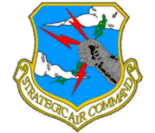MARS Station KØFCR
Ellsworth AFB, South Dakota
I joined the Air Force in 1956, went through basic and Heavy Ground Radio
tech school at Parks AFB and Scott AFB. I then shipped overseas to AACS
Squadrons on Iwo Jima and Guam. In April of 1957 I PCSed to Ellsworth AFB SB,
into the 28th Bomb Wing. Ellsworth was a SAC base then and still is.
The base was very secure as Gen. Lemay was still commander of SAC. It was very
difficult to get onto the base, even for dependents at night. This was because
almost all base housing was off the base proper. Rushmore AFS was next to the
base with its three fences surrounding it, the middle one being electrified.
Everybody knew what was there, NUKES.
Off base where I worked was the receiver. Transmitter, and MARS sites. The
receiver was a few miles east and the transmitter and MARS a few miles west. I
would estimate each had about 10 or more acres of land for antenna farms.
The MARS Station was an old wooden building with three rooms that was the
operations center. They also had a warehouse on base for storage. It was always
full as they were always getting equipment from base salvage. They got
everything from household goods to vehicles. The equipment was issued to MARS
members. Most they could keep as long as they did not sell or give away, some
was issued on a hand receipt. To be a MARS member, you had to be an Amateur
Radio Operator with a current license. I think any HAM could be a MARS member
military or civilian. I was not. My duty was to repair the equipment during my
stay there. I did not have the patience to learn the code. I could operate the
MARS Net, which I did not want to do. The MARS Net used frequencies assigned to
the MARS network. Each day at certain times they would pass traffic. They used a
transceiver for this. It was a Collins of some type, nonmilitary. It was the
first transceiver I had seen that was not in a vehicle. It was connected to the
huge rotatable Beam antenna atop a steel tower. I was told it was lifted up by a
helicopter when it was installed. Other antenna used were cut dipoles, whips and
a quad box antenna. One day the boss said "the box antenna is broke and somebody
is going to have to climb the pole and fix it." He was looking at me when he
said that. I said "it will be a col day you know where before I climb that pole,
they have people who go to pole climbing school to that."
In one room they had an old BC-610 transmitter which they sometimes used. Its
frequency was tuned by changing coils inside the transmitter. They had a whole
box of them. I used to watch as one guy used to load and tune the antenna with a
lead pencil. I did not like that too much as I was taught that heavy ground
transmitters were extremely dangerous and rightly so.
Some of the military had what looked like miniature Quonset Huts which they
stored their MARS equipment. Uncle Sam would ship this for them in addition too,
their household goods. Some used to cheat and slip in extra a non ship able
items like motorcycles. They had two, two and half ton trucks that had a
complete communication centers for use in emergencies. Never used while I was
there.
We used old vehicles which we obtained from the base salvage. The motor pool
just hated to work on them as they had condemned them in the first place.
Any MARS member could come and operate the equipment, but few did. They
mostly stopped by to see if we had any new stuff to give out. We also had
request from base people who were holding events like picnics, sporting events,
etc. We had PA systems. Portable generators and other equipment they wanted to
use. It was lent out only if one of the staff at the MARS station accompanied
it. I used volunteered to go as I like to eat and drink and enjoy my self at
those events.
In mid 1960 I was discharged from the Air Force only to return in 1962. That
ended my career in heavy ground radio. I worked on radar after that. So I am
stuck back in the days of tube radios, HF skip, teletype, CW and early SSB. No
trop-scatter, satellite, or much multiplexing. Some equipment I remember, are
the SP-600 and R-390 receivers, 96D (3KW) and BC-610 transmitters, and the
teletype processing equipment.
Dean Boys
deanboys@bmmhnet.com
October 15, 1998
Shelbyville, IL USA
Home
History
|

